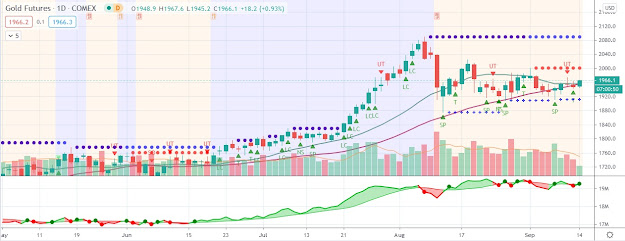Is the U.S. Economy Back on Track? So Gold Price Dips?
The price of gold gave back its earlier small gain on Thursday after
several better than expected economic reports in the U.S. The spot gold price
rose $5.91, or 0.3%, to an overnight high of $1,727.48 per ounce, but
later fell back toward unchanged at $1,719.23. In doing so, the gold
price remained firmly in the $1,700-$1,730 range that is has occupied
for the past two weeks.
Across the Pacific Ocean, financial markets were impacted on Thursday by an encouraging report on the Chinese economy. China’s National Bureau of Statistics reported that its Purchasing Managers’ Index – a key gauge of manufacturing activity – increased to 50.2 in October from 49.8 in September. The figure represented the first reading above 50, the level that separates expansion from contraction, since July. Furthermore, it was one of the few significant positive data points from China in recent months, as the nation’s economy has slowed considerably.
While the gold price showed a slightly positive response to the Chinese PMI data, it relinquished its advance after four better than expected economic reports in the U.S. The ADP Employment report showed job additions in October of 158,000, well above the 131,000 consensus estimate among economists. Weekly jobless claims fell to 363,000, below the 370,000 median estimate. Consumer Confidence rose to 72.2, beating the 72.0 consensus figure. Lastly, the ISM Index for October increased to 51.7, surpassing the 51.0 figure economists were expecting.
Despite the collection of signals this morning that the U.S. economy is holding firm despite many headwinds – from the ongoing European debt crisis to the looming fiscal cliff to the upcoming presidential election – the price of gold managed to mitigate its losses. In recent weeks, the gold price has held above $1,700 per ounce on several occasions – which many market strategists have attributed to the Federal Reserve’s pledge to maintain its third round of quantitative easing (QE3) and other accommodative monetary policies even as the U.S. economy improves.
Across the Pacific Ocean, financial markets were impacted on Thursday by an encouraging report on the Chinese economy. China’s National Bureau of Statistics reported that its Purchasing Managers’ Index – a key gauge of manufacturing activity – increased to 50.2 in October from 49.8 in September. The figure represented the first reading above 50, the level that separates expansion from contraction, since July. Furthermore, it was one of the few significant positive data points from China in recent months, as the nation’s economy has slowed considerably.
While the gold price showed a slightly positive response to the Chinese PMI data, it relinquished its advance after four better than expected economic reports in the U.S. The ADP Employment report showed job additions in October of 158,000, well above the 131,000 consensus estimate among economists. Weekly jobless claims fell to 363,000, below the 370,000 median estimate. Consumer Confidence rose to 72.2, beating the 72.0 consensus figure. Lastly, the ISM Index for October increased to 51.7, surpassing the 51.0 figure economists were expecting.
Despite the collection of signals this morning that the U.S. economy is holding firm despite many headwinds – from the ongoing European debt crisis to the looming fiscal cliff to the upcoming presidential election – the price of gold managed to mitigate its losses. In recent weeks, the gold price has held above $1,700 per ounce on several occasions – which many market strategists have attributed to the Federal Reserve’s pledge to maintain its third round of quantitative easing (QE3) and other accommodative monetary policies even as the U.S. economy improves.




Comments
Post a Comment